Evolutionary aspects of the development of teeth and baleen in the bowhead whale
- PMID: 28070906
- PMCID: PMC5345624
- DOI: 10.1111/joa.12579
Evolutionary aspects of the development of teeth and baleen in the bowhead whale
Abstract
In utero, baleen whales initiate the development of several dozens of teeth in upper and lower jaws. These tooth germs reach the bell stage and are sometimes mineralized, but toward the end of prenatal life they are resorbed and no trace remains after birth. Around the time that the germs disappear, the keratinous baleen plates start to form in the upper jaw, and these form the food-collecting mechanism. Baleen whale ancestors had two generations of teeth and never developed baleen, and the prenatal teeth of modern fetuses are usually interpreted as an evolutionary leftover. We investigated the development of teeth and baleen in bowhead whale fetuses using histological and immunohistochemical evidence. We found that upper and lower dentition initially follow similar developmental pathways. As development proceeds, upper and lower tooth germs diverge developmentally. Lower tooth germs differ along the length of the jaw, reminiscent of a heterodont dentition of cetacean ancestors, and lingual processes of the dental lamina represent initiation of tooth bud formation of replacement teeth. Upper tooth germs remain homodont and there is no evidence of a secondary dentition. After these germs disappear, the oral epithelium thickens to form the baleen plates, and the protein FGF-4 displays a signaling pattern reminiscent of baleen plates. In laboratory mammals, FGF-4 is not involved in the formation of hair or palatal rugae, but it is involved in tooth development. This leads us to propose that the signaling cascade that forms teeth in most mammals has been exapted to be involved in baleen plate ontogeny in mysticetes.
Keywords: FGF; Cetacea; baleen; baleen whales; bowhead whale; embryology; keratin; mysticetes; ontogeny; tooth development.
© 2017 Anatomical Society.
Figures

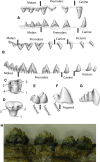
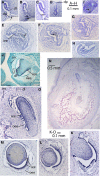
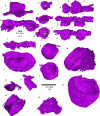
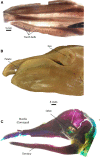
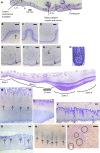
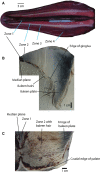

Similar articles
-
Prenatal developmental sequence of the skull of minke whales and its implications for the evolution of mysticetes and the teeth-to-baleen transition.J Anat. 2019 Oct;235(4):725-748. doi: 10.1111/joa.13029. Epub 2019 Jun 19. J Anat. 2019. PMID: 31216066 Free PMC article.
-
Prenatal Development of the Humpback Whale: Growth Rate, Tooth Loss and Skull Shape Changes in an Evolutionary Framework.Anat Rec (Hoboken). 2020 Jan;303(1):180-204. doi: 10.1002/ar.23990. Epub 2018 Nov 22. Anat Rec (Hoboken). 2020. PMID: 30332718
-
Tooth Loss Precedes the Origin of Baleen in Whales.Curr Biol. 2018 Dec 17;28(24):3992-4000.e2. doi: 10.1016/j.cub.2018.10.047. Epub 2018 Nov 29. Curr Biol. 2018. PMID: 30503622
-
The genetic basis of modularity in the development and evolution of the vertebrate dentition.Philos Trans R Soc Lond B Biol Sci. 2001 Oct 29;356(1414):1633-53. doi: 10.1098/rstb.2001.0917. Philos Trans R Soc Lond B Biol Sci. 2001. PMID: 11604128 Free PMC article. Review.
-
Conserved developmental processes constrain evolution of lungfish dentitions.J Anat. 2001 Jul-Aug;199(Pt 1-2):161-8. doi: 10.1046/j.1469-7580.2001.19910161.x. J Anat. 2001. PMID: 11523818 Free PMC article. Review.
Cited by
-
Comparative embryology of Delphinapterus leucas (beluga whale), Balaena mysticetus (bowhead whale), and Stenella attenuata (pan-tropical spotted dolphin) (Cetacea: Mammalia).J Morphol. 2023 Feb;284(2):e21543. doi: 10.1002/jmor.21543. J Morphol. 2023. PMID: 36538588 Free PMC article.
-
Morphological variation of the relictual alveolar structures in the mandibles of baleen whales.PeerJ. 2021 Jul 30;9:e11890. doi: 10.7717/peerj.11890. eCollection 2021. PeerJ. 2021. PMID: 34395101 Free PMC article.
-
Heterochronic truncation of odontogenesis in theropod dinosaurs provides insight into the macroevolution of avian beaks.Proc Natl Acad Sci U S A. 2017 Oct 10;114(41):10930-10935. doi: 10.1073/pnas.1708023114. Epub 2017 Sep 25. Proc Natl Acad Sci U S A. 2017. PMID: 28973883 Free PMC article.
-
From teeth to pad: tooth loss and development of keratinous structures in sirenians.Proc Biol Sci. 2023 Nov 29;290(2011):20231932. doi: 10.1098/rspb.2023.1932. Epub 2023 Nov 29. Proc Biol Sci. 2023. PMID: 38018114 Free PMC article.
-
Lateral palatal foramina do not indicate baleen in fossil whales.Sci Rep. 2022 Jul 6;12(1):11448. doi: 10.1038/s41598-022-15684-8. Sci Rep. 2022. Retraction in: Sci Rep. 2025 Feb 11;15(1):5029. doi: 10.1038/s41598-025-88714-w. PMID: 35794235 Free PMC article. Retracted.
References
-
- Armfield BA (2010) The evolution and development of mammalian tooth class. PhD dissertation, Kent State University: Kent, Ohio, USA.
-
- Armfield BA, George JC, Vinyard CJ, et al. (2011) Allometric patterns of fetal head growth in mysticetes and odontocetes: comparison of Balaena mysticetus and Stenella attenuata . Mar Mam Sci 27, 819–827.
-
- Barnes LG, Kimura M, Furusawa H, et al. (1994) Classification and distribution of Oligocene Aetiocetidae (Mammalia, Cetacea, Mysticeti) from western North American and Japan. Island Arc 3, 392–431.
-
- Bhussry BR (1980) Development and growth of teeth In: Orban's Histology and Embryology, 9th edn (ed. Bhaskar SN.), pp. 24–45. St. Louis, Missouri: CV Mosby.
MeSH terms
LinkOut - more resources
Full Text Sources
Other Literature Sources
Research Materials

